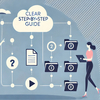
Every time we come across instructions, manuals, online ‘help’ articles, or other technical documents, we have to deal with the results of component authoring. However, many people still don’t understand what it is and why component content has become the basis of every ‘standard’ text, from a restaurant menu to complex packages of technical documentation. This blog is intended to explain what component authoring is and its role in technical writing.
What Is Component Authoring?
The amount of text (or, generally, content) has been growing exponentially, together with the growth of population and facilitation of access to education and knowledge. In the Middle Ages, for example, books were rare. People looked at books as a treasure and used to decorate them with gold and gems. A book was regarded as a unique piece of art.
Time went by, and the amount of knowledge and text as its manifestation increased. In Modern Times, knowledge was popularized. Books became more accessible and less ‘sacred.’
In the first half of the 20th century, the term mass education was introduced. This meant that every student now had access to public libraries. But, still, a text was regarded as something individual – a creation of one mind and one author who spoke a special language. It was a time when a book could be compared to a painting or sculpture, as it bore the traces of the author’s (artist’s) hand no matter what genre it referred to, belles letters, religion, medicine, or engineering.
The second half of the 20th century brought about a qualitative change. The text was converted into digital form. At this stage, it became easier to compare texts and see the common elements that made it possible to apply the word template to a text. This caused a change in the perception of content. From now on, texts were no longer unique. They transformed into discrete units made of standard blocks.
The introduction of component authoring was a logical step in content management. If a text or a multitude of texts could be ‘taken apart’ or broken into components, a new text could be assembled from these parts.
As a result, the text was ‘de-individualized.’ It no longer needed an Author. Instead, it could be created automatically or by several writers in the process of teamwork.
It was like the industrial revolution in writing when the introduction of assembly lines optimized the production process.
This made the ‘authoring process’ cheaper and products with information support in a text form more accessible to customers.
Comparison of CMS and CCMS
A Content Management System (CMS) is a term usually applied to web design and website creation. It offers simple tools for combining large elements of content, among which the most usable ones are templates, themes, plugins, etc.
A Component Content Management System (CCMS) is based on the same main principle of content creation, but in addition to combining content elements, it offers special features which make the system more effective.
The first addition is the single-sourcing approach, which allows for deriving documents from one centralized source. Within this approach, documents are regarded as variables originating from one standard doc. This is important when writers have to deal with a large scope of information from similar documents, like specs, data sheets, instruction manuals, catalogs, etc.
Similar content requires tools for content reuse. Otherwise, the reproduction of similar texts will be too time- and effort-consuming. Component content management is an adequate solution to this problem.
Another important feature is that, due to centralization, technical writers can publish multiple outputs (or formats) from one source and distribute them across multiple channels.
The thing that will help to understand the difference between CMS and CCMS is the unit or element that is in focus. While a content management system works with large elements like documents or whole texts (represented in the form of posts, blogs, pages, etc.), a CCMS breaks texts into a multitude of grain-size fragments. This approach is often called granularity, as it allows to manage content at the level of very small components or ‘grains’ used to assemble larger output texts.

What Does a CCMS Include?
To sum up the advantages of component content management, let’s have a look at the basic features of CCMS:
Single-Sourcing
This is the first feature that makes CCMS stand out against the background of traditional content management systems. It guarantees the coherence of the content published in different outputs.
For example, the legal address of your company specified in the headers of all documents has changed. As a result, people in your company will have to make adjustments to all the documents they issue, including different outputs (PDFs, presentations, user guides, etc.). In this situation, you will hardly be able to avoid mistakes. Someone is sure to forget that a new legal address is required.
But with single-sourcing, you no longer have to adjust each document separately. You have to go to the ‘source element’ and change it. After that, all the members of your team will just use the updated element.
Single-sourcing is one of the CCMS authoring tools that help you to centralize content. Moreover, it helps to unite all your employees in one team, as they will no longer have questions about versioning or reviewing the status of your docs, etc.
Fast Search
This is another feature that makes CCMS special. In the case of CCMS, all content is broken into components usually stored on a cloud. This makes it possible for the user to search for the information not in the context of one specific document the user is working on (or in several docs one by one) but in a context-free environment. With CCMS, you can search all text components of the company’s knowledge base. This means no more downtimes in work, as your employees will no longer lose their time looking for the information they need, writing requests, or searching the archive.
Content Reuse
Content reuse allows reusing components in new documents. This is one of the handiest component authoring solutions, as it saves a great deal of time for a technical writer. Without content reuse, working time is usually wasted on reproducing similar texts again and again. The availability of ready-made components from previous projects allows content writers to move, delete, rearrange, or adjust elements to build new documentation.
Multi-Channel Publishing
Imagine a simple routine situation you can face at work practically every day when you author a document in DOC. format and then have to convert it into PDF or HTML. So, you usually use special software for converting into various formats. Such soft can be easily found online, but, as a rule, the amount of docs converted free of charge is limited, and when you have a large scope of documentation, you have to pay for converting it.
With CCMS, you can create documents and distribute them in various outputs without using any additional software and paying for it. This means reducing time and costs for the production of content (printed format for hard copies, PDF, web, mobile, web app, etc.).
Structured Content
CCMS allows the production of structured content by customizing TOCs (tables of contents). You can add or delete TOC elements and add or remove levels, making your TOC branched or, on the contrary, simple.
This is not the only way you can format your information architecture. CCMS actually allows you to create a special writing environment with stringent software control. This will make all your documents preserve the same structure and style. It is especially important if you want your documentation to look consistent.
Traditionally, the problem of consistency was solved by introducing company style guides. However, this solution still left some room for the ‘human factor’ – an employee could simply overlook some of the rules and, for example, use Times New Roman instead of the Arial font required in the style guide.
With CCMS, this problem is eliminated by introducing doctype and stylesheets. Due to this, there will be no chance of inconsistency in your documentation.
Easy Localization
CCMS gives new opportunities for translation and localization. The component principle has already become the basis of all state-of-the-art translation software. Usually, translators specialize in one or several related fields, like medicine, engineering, oil and gas, construction, IT, etc. They usually have to deal with typical projects with similar structure and content.
As soon as texts (documents) are uploaded to the translation program, they a split into components that are stored on a cloud. This applies not only to the source but to the target text as well (translated texts are also broken into components).
Whenever a similar text is uploaded, the system analyses its content and substitutes the identical elements with the components that have already been translated. If the components are not 100% identical, the program highlights the fragments that are different.
This allows the creation of outputs for various target audiences speaking different languages.

Conclusion
A couple of decades ago, text was the focus of all processes related to writing. The text was regarded as a unity where all fragments or components were integrated by context. In component authoring, the focus has been shifted from text to content. It is a new approach to content creation and management based on content not as a unity but as a multitude of fragments or components. The latter are independent context-free units. This allows using them as ‘building blocks’ for creating new content. The component approach helps to optimize the workflow, spend less time and effort on creating and editing documents, and increase the overall cost-efficiency of your business.
Good luck with your technical writing!
ClickHelp Team
Author, host and deliver documentation across platforms and devices


